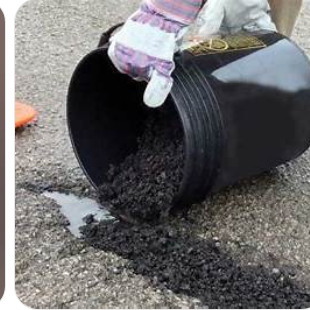Potholes are one of those things that seem to appear overnight—often in the most inconvenient spots. Whether it’s your driveway, a private road, or a business yard, these craters can damage vehicles, create tripping hazards, and get worse over time if not dealt with properly.
While major roads and highways must be maintained by local authorities, if a pothole appears on your private property, you can legally fix it yourself. And with the right tools and materials, it’s more straightforward than you might think.
Important Note Before You Start
It’s crucial to point out that DIY pothole repair is only permitted on private land. Public roads, pavements, and highways are the responsibility of your local council or Highways Agency, and it is illegal for individuals to attempt repairs on public land. Always check if the surface you’re repairing falls under your ownership or lease before getting started.
Step 1: Clear Out the Pothole

Start by removing all debris from the pothole. That includes loose tarmac, stones, dust, weeds, and standing water. You want a clean, dry surface so the materials you apply later will adhere properly. Using a stiff brush or even a blower can help get rid of stubborn bits. If the hole is damp, try drying it out with old rags or leave it to air dry for a few hours before continuing.
Step 2: Cut a Clean Edge (If Possible)
While not always essential, cutting a neat square or rectangle around the pothole can help your repair last longer. Jagged edges are more likely to fail over time, so creating a tidy border gives the cold lay tarmac something solid to bind to.
You can do this with a bolster chisel and hammer or an angle grinder if you’re experienced and have the right PPE. The idea is to create vertical edges that hold the new material firmly in place.
Step 3: Apply Cold Joint Sealer
Before filling in the hole, run a bead of bitumen cold joint sealer around the edges of the prepared hole. This acts like a glue between the existing road surface and your new tarmac. It helps prevent water ingress and stops the patch from working loose over time. You can use a brush or nozzle depending on the type of sealer you’ve bought—just make sure the entire edge is coated evenly.
Step 4: Fill with Cold Lay Tarmac

Now it’s time to fill the hole. Pour in your cold lay tarmac, slightly overfilling the hole so you can level it off. Use a rake or shovel to spread the material evenly so it matches the height of the surrounding surface.
Take your time with this step—an uneven patch not only looks messy but can also affect vehicle movement or encourage water pooling, which leads to future damage.
Step 5: Compact the Surface
Once your tarmac is level, it’s time to compact it. You can use a punner (tamper) for small patches, applying firm, even pressure across the surface. For larger jobs, a vibrating compaction plate will give better results and a longer-lasting finish.
Make sure the surface is flush with the surrounding area. After compacting, give it a few hours (or follow the product instructions) before driving over it to allow everything to settle properly.
Where to Find the Right Materials
For a job like this, having the right gear makes all the difference. From cold lay tarmac to joint sealers and compaction tools, Ready Set Supplied offers a range of products that can help you get the job done efficiently and professionally. Whether you’re patching up a private driveway or sorting a neglected car park, they’ve got the essentials to make the process smoother.
DIY pothole repair might sound intimidating, but with a bit of preparation and the right materials, it’s a highly achievable weekend project. It’s not just about fixing a hole—it’s about protecting your vehicles, improving safety, and taking pride in maintaining your property.

